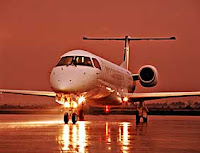 The Federal Aviation Administration (FAA) has issued a Safety Alert for Operators (SAFO) to call attention to "the possibility that a pilot of an Embraer Legacy, EMB-135 or -145 (sometimes called EMB-140 in marketing literature) might inadvertently change VHF radio frequencies or place the ATC transponder into standby mode during flight."
The Federal Aviation Administration (FAA) has issued a Safety Alert for Operators (SAFO) to call attention to "the possibility that a pilot of an Embraer Legacy, EMB-135 or -145 (sometimes called EMB-140 in marketing literature) might inadvertently change VHF radio frequencies or place the ATC transponder into standby mode during flight."Quoting from FAA-SAFO 07005, issued on July 3, 2007:
Background: During an investigation the FAA discovered that crewmembers who had the simple habit of placing their shoe on the footrest just below the instrument panel could inadvertently put the ATC transponder into standby mode, or change radio frequencies without the crew's awareness.Any questions regarding the content of this SAFO should be directed to the Air Transportation Division, AFS-200, at (202) 267-8116.
Further, they found that pilots might not notice the corresponding indication on the Pilot Flight Display due to the white colored letters, which are not as noticeable as differently colored caution or warning indications.
Switching a transponder with a functioning traffic alert and collision avoidance system (TCAS) to standby mode renders the TCAS ineffective, and is therefore one of the most serious consequences of a pilot’s foot inadvertently contacting the radio management unit. Two airplanes equipped with TCAS would fail to see each other if they were on a collision course. Pilots could presume TCAS was operating normally if they failed to notice the subtle TCAS OFF indication on the Pilot Flight Display.
Recommended Action: Managers of part 142 training centers where pilot training on the Embraer Legacy, EMB-135, and EMB-145 is conducted should ensure that their trainers caution pilots of this latent hazard and emphasize the importance of being careful when using the footrests provided.
Similarly, directors of safety, directors of operations, trainers, and check airmen for operators flying any of these Embraer models should immediately make this hazard known to their pilots and should make sure that it is addressed in their training programs, especially during flight training, supervised operating experience, and line checks.
[Photo Source]
